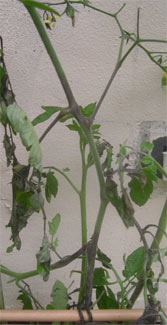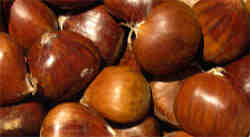Tomato Blight
Posted by Fiona Nevile in Fruit | 150 comments We have blight. When we were rushing out yesterday evening I spotted it on three tomato plants. Large blackish brownish splodges and a generally wilty look. It is unmistakeable. We had it five years ago and it devastated our tomato crop within days.
We have blight. When we were rushing out yesterday evening I spotted it on three tomato plants. Large blackish brownish splodges and a generally wilty look. It is unmistakeable. We had it five years ago and it devastated our tomato crop within days.
At the time we were creating a website for an expert on plant diseases. The fee was to be paid in whisky. Danny must have negotiated this deal.
The expert arrived with a rather good bottle of Isla whisky under his arm. He was immediately shepherded out to examine the tomatoes.
“Its blight. Just like potato blight. They’re the same family.”
It was hard to discuss his website. We were mourning the loss of a summer plucking sun warmed fruit from the plant and a long winter savouring our intense tomato sauce base. A good harvest makes enough sauce to last us through the winter until June.
We lost our entire crop that year. Now I grow tomatoes in at least two places. The blight has affected the plants at the front on a sunny south west facing wall. Usually the warmth of the wall nurtures the plants but warm and extended wet weather conditions are perfect for the development of tomato blight. I have hoiked out the plants and am hoping the blight spores will not have spread onto the other 12 plants. The blight affected the weakest plants, the others all look strong and healthy. If the wet weather continues for much longer I am afraid that they all will succumb.
The remaining plants could be treated with Bordeaux Mixture which was developed in France to treat fungal disease in vines. A lot of people spray their potatoes with this potion to protect against blight. It is a copper and lime mixture that is not environmentally friendly, so I am loathe to use it on our tomato plants.
Leave a reply






forgot to leave location stockton on tees north east question how quickly will blight kill the plant cos mine have it for at least a month and there still producing fruit am willing to let them go on growing to see what happens have removed all infected fruit and leaves will cut back the stems on 1 plant and leave the other 2 will this experiment help any one or should i just destroy the infected plants will also remove fruits from all 3 plants and see if they turn black in a couple of days thanks again for your help and me heart goes out to all of you me 1st year at growing anything all other veg diong fine chins up dont let the blight gete you down
Hi Peter
Thanks for dropping by and leaving a comment.
Blight spores love an enclosed, humid environment. Given these conditions, they breed like mad. Your greenhouse would be the perfect space for blight to develop rapidly even if you keep the door open 24/7.
Blight spores are airborne so if you are moving your greenhouse you might be OK vis a vie your spuds (if you deep clean your greenhouse to remove any spores before it is shifted). Personally, I wouldn’t plant spuds in a greenhouse that has been infected with tomato blight. Potatoes and tomatoes are the same family and are susceptible to the same diseases. Plant your spuds well away from the greenhouse and protect them with sterilised cloches.
If we have a bitterly cold winter with long periods of hard frost, the blight spores will be killed. It has to be a very hard winter to kill the spores in your greenhouse, even if you leave the door and window open.
Burn all plants infected with blight and never chuck them in the composter as you will be spreading blight infested compost on your crops next year.
so glad i stumbled across this site i bought 4 plants from a local grower and 2 from the garden centre all about 2-4 inches used 2 grow bags and put 2 local growers and 1 garden center one in each grow bag and left them out doors when they were about 3-4 feet tall i moved one set into the green house ane the other set i built a frame 3inches high just bigger than a grow bag put a new grow bag in it cut out the top dragged the other toms on top and cut away the bottom of the grow bag and left them to it the ones in the green house have blight {which i didnt know till i found you lot and have had it for a while } the ones out side are doing fine but the question is : im moving the green house to get more space and thats where i was going to plant me spuds will the excess water from the grow bag effect the soil for the spuds and any theories as to why the green house and not the out doors ones were infected thanks for any info
Thank you Kate for giving details of two more areas where blight is prevalent.
How disappointing to have such a small harvest from your 20 squash plants. My plants are still almost the same size as when I put them in 6 weeks ago!
Glad to hear that the baby plums toms are doing well. Do you know the variety? We have a selection of toms hanging on but my heart sank with this wet and windy weather. They could succumb to blight if this lasts for a few days.
We have blight in Marlow, Bucks. my niece has it in Bridport Dorset.Seems pretty widespread!
Ludicrous amounts of mildew on courgettes this year, plants pathetic, but as we had some sun last week I have had 4 squashes this week.Total this year from abut 20 plants less than 20 fruits.
My last three tomato plants are doing well,they are baby plums and despite a bit of browning on the leaves they seem much more resistant to the blight than black cherry,sungold,marmande,love heart and russian black, which all succumbed.I shall try them again next year.
Hi Anna,
Thanks for leaving a note of your location re tomato blight areas.
I’m not sure what problems courgettes are prone to apart from mildew. Ours have been hopeless this year. Usually I grow them in pots and they do well. This year I just have one left in the ground. A tiny weak plant with one flower.
Glad to hear that yours are doing well.
I’m in Oxfordshire and lost all mine to blight and a friend’s Dad lost his in Nottingham. Think it’s pretty much everywhere.
For the record, our courgettes are growing great guns! What problems do they get – apart from mildew?
Hi Ian,
Bad luck losing your tomato plants.
I think that the problem is probably pretty widespread. Loads of people that I know have lost their entire crop (East Anglia). We are battling on here, having lost a good chunk of our crop. I removed the blighted plants as soon as I could and this seemed to stop it spreading. The sunny weather has helped a lot. I don’t have any in the greenhouse this year. Our plants are situated beside a sunny wall.
First saw it last week. I have tried Dithane but it is still spreading. All for the dustbin tomorrow sadly.
Is the problem throughout the UK? I am in Windsor but none of the other replies seem to mention a location.
Hi Richard,
Thanks for adding your comment about your success with Dithane 945. It’s good to know what works if you are going down the non organic route.
Hi Kate(uk),
This seems sound advice if you are not sure what to do with your remaining green toms. I do hope that you have some for the village show.
Hi Mike,
I have found a couple of black toms on a few of my plants with no evidence of blight on the stems and leaves a couple of weeks ago. I quickly removed the blackish/green toms and the rest all seem fine. As I have other tom plants in different areas of the garden I can afford to experiment a bit to see what happens regarding the black toms. However, if I have found evidence of blight on the stems and leaves of plants I have removed the plants immediately and burnt them.
There is no need to chuck the healthy looking green toms. The safest thing to do is to harvest them and ripen them indoors on trays. If they are affected they will turn black within a few days.